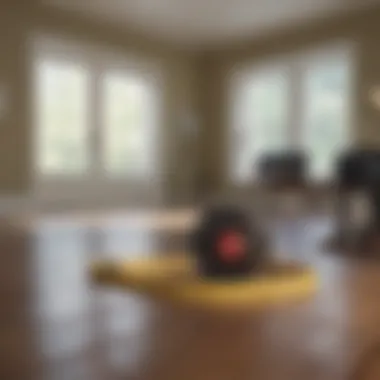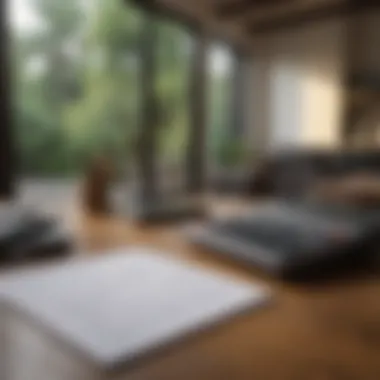How to Accurately Measure Square Feet of a House


Intro
Understanding how to measure the square footage of a house is a fundamental skill for various stakeholders in the real estate market, from prospective buyers to seasoned investors. Square footage can significantly influence property valuation, interior design planning, and effective space management. Misjudgments in these areas can lead to financial loss or inefficient use of living space. This article lays out a comprehensive framework to accurately determine the square footage of a home through systematic approaches, detailing the most effective measurement techniques while highlighting common mistakes to avoid.
The key concepts we will cover include exterior measurements, room-by-room calculations, and the relevance of square footage in real estate transactions. This guide helps homeowners, real estate professionals, and design enthusiasts acquire the skills needed to properly assess residential spaces. Let's explore the essentials of measuring square footage in-depth.
Preface to Square Footage
Understanding square footage is crucial for anyone engaged in real estate, interior design, or property management. This foundational knowledge helps homeowners and professionals alike to assess and optimize space usage effectively. A well-calculated measurement not only influences decisions about buying or selling a property but also impacts renovation plans and furniture layouts. Therefore, this section lays the groundwork for grasping square footage, emphasizing accuracy and the various methods for measurement.
Definition of Square Footage
Square footage refers to the total area of a space measured in square feet. This figure is obtained by calculating the length and width of a room or building and then multiplying these two values. For example, if a room measures 10 feet by 15 feet, the square footage would be 150 square feet (10 feet x 15 feet = 150 square feet). This straightforward calculation provides a quantifiable metric that can be universally understood, which is vital for property assessments and comparisons.
Importance of Calculating Square Feet
Calculating square footage accurately serves several important purposes. Here are some key reasons why this measurement is critical:
- Property Valuation: Square footage directly influences a property's market value. Buyers often look for larger spaces, making this metric essential in real estate.
- Space Management: Understanding square footage helps in planning interior layouts, ensuring efficient use of space for furniture, appliances, and activities.
- Legal and Regulatory Compliance: Many regions have specific requirements regarding disclosures of square footage. Proper calculations help meet these regulations.
- Cost Estimates for Renovation: When planning renovations, knowing the square footage helps estimate material and labor costs accurately.
Accurate square foot measurements help establish a realistic understanding of property value and usability. Miscalculations can lead to disputes and financial losses.
In essence, an accurate understanding of square footage underpins many critical decisions in real estate and interior design. This article will further explore various methods and considerations in measuring square footage, with an eye toward helping readers avoid common pitfalls.
Tools Required for Measurement
Understanding the tools necessary for measuring square footage is crucial for anyone seeking to determine the area of a house accurately. The right instruments can simplify the process and help achieve precise results. In this section, we will explore the primary tools used for measurement, their benefits, and considerations for each.
Measuring Tape
A measuring tape is perhaps the most traditional tool for determining dimensions. It is commonly made of flexible steel or plastic, allowing for easy measurement of various surfaces. Measuring tapes come in various lengths and widths, typically 25 to 100 feet, and are equipped with markings for inches and feet, making them user-friendly.
Utilizing a measuring tape is straightforward. Simply extend it along the length or width of the area you wish to measure and record the value. This method is particularly beneficial for measuring irregular spaces or contours, where digital devices may fall short.
However, accuracy can diminish with poor handling. It’s necessary to ensure the tape remains flat against the surface for reliable readings. Additionally, holding the tape alone can be challenging for longer distances, so assistance might be valuable.
Laser Measure Device
A laser measure device brings a modern approach to calculating distances. Utilizing laser technology, this tool can accurately measure long distances quickly, making it ideal for larger spaces. Many devices can cover distances of up to several hundred feet, usually with just a press of a button.
The benefits of using a laser measure include:
- Precision: These devices provide highly accurate measurements, reducing human error.
- Efficiency: A laser measure can take measurements in seconds, saving time during the whole process.
- Versatility: Many models offer additional features like calculating square footage, volume, and even indirect measurements.


Using this device may require some practice to align the laser correctly for optimal results. However, once familiar with it, measuring spaces becomes a seamless task.
Optional: Floor Plan Apps
With the rise of technology, floor plan apps have gained popularity among homeowners and real estate professionals alike. These applications allow users to create digital blueprints of rooms and entire houses simply by inputting measurements or taking photos.
Some advantages of floor plan apps include:
- Simplicity: Many apps are user-friendly, making them accessible to individuals without technical experience.
- Visualization: They help in visualizing your measurements in a layout format, enabling better interior design planning.
- Convenience: With apps readily available on smartphones, you can measure and document spaces wherever you are.
Though they provide useful tools, it's essential to ensure that the app you choose can accurately interpret measurements. Not all applications have the same precision and reliability, so testing before committing to a specific one is wise.
Using the proper tools for measurement is essential. They not only ensure accurate calculations but also save time and effort in the long run.
Measurement Techniques
Understanding measurement techniques is crucial for accurately determining the square footage of a house. Different methods cater to various needs and preferences, allowing for flexibility depending on the specific environment or purpose. These techniques hinge on clear, systematic processes that ensure consistency and validity in measurements. Perhaps the most significant benefit of using established measurement techniques lies in the reduction of human error, enabling one to obtain reliable data that holds value in practical applications such as real estate, renovation planning, or even sales listings.
Exterior Measurements
Exterior measurements involve taking the dimensions of a house’s exterior walls. This method serves as a straightforward approach for determining total square footage. It typically starts at one corner of the building and proceeds along the boundary to the opposite end, ensuring that all sides are measured accurately. Using a measuring tape or a laser measure device enhances the accuracy of these measurements.
One benefit of exterior measurements is that they encompass all usable space without being impacted by the internal layout. However, they may not reflect specific intricacies or irregularities inside, such as alcoves, nooks, or extensions. Such features might create issues with precision, making it essential to complement external measurements with internal checks for want of accuracy.
Room-by-Room Calculation
Room-by-room calculation takes a more detailed approach to measure square footage. It involves determining the area of individual rooms and summing them to obtain the overall house area.
Calculating Individual Room Areas
The process of calculating individual room areas is both methodical and essential for achieving an accurate total square footage. This technique entails measuring the length and width of each room and then applying the formula: Area = Length x Width. This straightforward calculation allows for precise data capture concerning specific living spaces.
A key characteristic of calculating individual room areas is that it highlights variations in room sizes, especially when dealing with multi-functional spaces. Notably, this method is beneficial because it often reveals discrepancies in layout and can help identify areas that might be overlooked using exterior measurements alone. While this technique is thorough, it can be time-consuming and may require more detailed planning.
Adding Up Room Areas
Adding up room areas is the next logical step following individual room calculations. Once you have found the area for each room, the areas are summed together to produce a comprehensive total.
A salient aspect of this method is that it compiles a balanced overview of the home’s usable space. It allows for a more nuanced understanding of the layout, which can influence real estate decisions or renovation choices. The unique feature here is the granularity of data; it gives homeowners insights into how their living areas connect and function as a whole.
Despite its advantages, the process of summing up room areas has potential drawbacks, particularly if measurements are inconsistent or if rooms have unusual shapes. Precision in every step is vital to avoid compounding errors.
Multi-Story Considerations
When dealing with multi-story houses, measuring square footage requires additional considerations. It involves assessing the area on each level, which can bring complexity to the process. This could include evaluating stair spaces, which may be included or excluded based on the measuring guidelines followed.


In such cases, maintaining a methodical approach becomes paramount. One common tactic is to treat each level as a separate entity and then combine their total areas at the end to ascertain overall square footage. Ensuring consistency with respect to ceiling height is also crucial, particularly when defining livable spaces. Proper attention to detail in multi-story calculations can significantly affect the valuation and usability perception of a property.
Common Pitfalls in Measurement
Understanding the common pitfalls in measuring a house's square footage is essential for anyone involved in real estate, interior design, or home management. Getting accurate measurements influences property value, affects resale potential, and guides renovation efforts. Failing to recognize missteps in measurement can lead to significant discrepancies in the size calculation, thus impacting financial decisions.
Ignoring Unusable Space
One major pitfall is ignoring unusable space during measurements. This includes areas such as walls, closets, and mechanical rooms that do not contribute to livable space. Many people focus solely on floor area, neglecting to account for how much of that area is actually usable. For instance, if a room has large built-in cabinets that take up floor space but are not counted in usable footage, the effective square footage can be significantly less than reported. Therefore, a clear understanding of what constitutes usable space is crucial. This distinction can avoid inflated perceptions of a property's true size.
Mistakes in Measurement Techniques
Another common issue arises during the actual measurement process. Small mistakes in measurement techniques can lead to larger errors in square footage. For example, failing to hold the measuring tape straight or misreading numbers can result in incorrect totals. Additionally, using a tape measure that is not properly calibrated or damaged can introduce faults. Using digital devices like laser measures can minimize these mistakes, but they also require a basic understanding of how to use the tools effectively. Ensuring accuracy often involves double-checking measurements and employing consistent techniques. This helps maintain the integrity of the reported square footage.
Overlooking Architectural Features
Architectural features can complicate square footage calculations if they are overlooked. For example, vaulted ceilings, alcoves, or significant structural elements can inflect how square footage is perceived. While these features can enhance appeal, they may also change how space is incorporated into the overall square footage. It's crucial to assess how these elements factor into the calculations. If an architectural feature takes away usable space, it should be accounted for in the final measurement. Missing these details can lead to misvaluation of properties and dissatisfaction among potential buyers or renters who expect specific space allocations.
"Attention to detail is key in measurement. Small mistakes can lead to big misconceptions."
In summary, being cognizant of these common pitfalls is vital. Each error can compound, leading to significant discrepancies in understanding the true square footage of a house. Addressing these issues not only helps in achieving accurate measurements but also contributes to better decisions in real estate and design.
Understanding Living Space vs Usable Space
Understanding the distinction between living space and usable space is pivotal when calculating the square footage of a house. This knowledge helps in providing a clearer picture of the property’s layout, maximizing the effective use of space, and ultimately influencing the valuation and marketability of a property.
Defining Living Space
Living space refers to the areas within a house that are designed for routine activities. These spaces include living rooms, bedrooms, bathrooms, and kitchens. Importantly, living space typically encompasses areas that enhance the functionality of a home for its inhabitants. To be classified as living space, the area must meet certain minimum requirements, often including proper ventilation, heating, and natural light access. By focusing on these specifics, homeowners and prospective buyers can assess how well a property meets their needs.
Distinguishing Usable Space
Usable space, on the other hand, dives deeper into functionality and adaptability. It includes not only the areas classified as living space but also those that can be rearranged or modified for practical use. This might involve spaces like attics, basements, or even garages, provided they can be adapted for some kind of living or functional purpose. Understanding usable space is important because it enables homeowners to factor in additional areas that can contribute to the overall utility of a property. Assessing usable space informs decisions about renovations, financing, and property modifications.
In summary, while both living space and usable space contribute to the total square footage of a house, recognizing the differences is essential. A thorough understanding aids in making informed decisions regarding real estate investments, enhancing the living experience, and optimizing the available space.
Square Footage and Real Estate Implications
Understanding square footage plays a vital role in real estate. It is not just a number; it has a direct impact on various aspects of property valuation and marketability. Knowing the precise dimensions of a home can affect how buyers perceive value, guiding their decisions in the competitive landscape of real estate transactions.
Here are a few important points regarding square footage in real estate:
- Pricing Strategy: The per-square-foot method is commonly used in real estate markets. Understanding this can help sellers price their properties accurately. Buyers often compare homes based on square footage, which can influence their offers.
- Market Analysis: Square footage helps in assessing the characteristics of properties within a certain area. This can aid in determining the current trends and fluctuations in local markets.
- Condition of Properties: Larger homes do not necessarily equal higher values. The condition and layout can significantly impact how square footage is perceived. Buyers might prioritize usable and livable space over total square footage.
Accurate measurement of a home can ultimately affect its market value, influencing how it competes against similar properties in the area.


How Square Footage Affects Property Value
Square footage is one of the fundamental aspects that dictates a property’s value. When evaluating homes, appraisers often reference square footage to gauge worth. Factors such as location and amenities are consequential, but square footage serves as a base measurement.
In terms of property value, consider the following:
- Comparative Market Analysis: Agents will analyze sales of similar homes nearby, often focused on the price per square foot. This allows for reasonable valuation against other properties in the market.
- Investment Opportunities: Investors look for properties with favorable square-footage ratios. A reasonable investment often involves balancing acquisition costs per square foot against potential rental income or resale value.
- Resale Potential: When considering future resale, homes with significantly larger square footage may have appreciation potential. However, layout and design play an equally crucial role in retaining value.
Square Footage in Listing Descriptions
How square footage is presented within a listing affects buyer impressions from the start. Listing descriptions that feature square footage in a clear and strategic manner can attract attention. For instance, emphasizing livable space over total area can align with target buyers’ priorities.
Guide to effectively incorporate square footage in listings:
- Be Transparent: Clearly state the square footage and specify what it includes. Distinguish between livable space and unattached areas like garages or attics.
- Highlight Unique Selling Points: If the property has an unusual layout that maximizes space, stress these aspects in descriptions. A well-designed 2000 square foot home might feel larger than a poorly designed 2500 square foot property.
- Focus on Usable Areas: Emphasize areas such as open-concept living spaces, large bedrooms, or finished basements which enhance living experience.
Regulations and Guidelines
Understanding the regulations and guidelines related to measuring square footage is vital for ensuring accuracy. Local laws may dictate specific methods or standards to follow. This can help avoid disputes and ensure compliance, particularly in real estate transactions. Additionally, awareness of guidelines can enhance the credibility of your measurements, aiding in negotiations and property assessments.
Local Regulations on Measurements
Local regulations can vary significantly from one jurisdiction to another. It is crucial to check these regulations before attempting to measure square footage. In some areas, square footage calculations must include specific elements, such as attics or basements but exclude areas like garages or balconies.
Many municipalities require permits for significant renovations, and you might need to adhere to specific guidelines when presenting square footage in listings or marketing materials. Familiarizing yourself with these rules helps avoid legal issues and maintains transparency with potential buyers or tenants. Here are some key considerations:
- Requirements: Check if there are mandatory features to include or exclude.
- Documentation: Understand what documentation may be required for selling or renting property.
- Accuracy: Stay compliant to prevent misleading statements regarding property size.
Industry Standards for Measurement
Following industry standards for measuring square footage adds consistency and professionalism to your approach. Various organizations, such as the American National Standards Institute (ANSI), provide guidelines that many professionals follow. These standards often focus on how to measure different spaces effectively.
Adhering to these standards is beneficial because it:
- Enhances Clarity: Buyers gain a clear understanding of the property size.
- Promotes Fairness: Standardized methods can reduce disputes over measurements.
- Increases Marketability: Properties measured according to such standards are considered more credible.
In summary, ensuring compliance with local regulations and industry standards is essential when calculating square footage. This not only protects you legally but also enhances your professional reputation in real estate or interior design.
The End
Understanding how to accurately assess the square footage of a house is crucial for multiple reasons. This knowledge is not only beneficial for homeowners but also essential for real estate agents and interior designers. The importance of accurately measuring a house cannot be overstated. It influences property valuations, impacts buyer decisions, and aids in effective space management.
Summary of Key Points
- Accurate Measurements Are Essential: Correctly measuring square footage ensures you know the actual size of your home, avoiding misunderstandings in real estate transactions.
- Consider Usable vs Living Space: Recognizing the difference between both types of spaces helps in understanding the total area available for practical use.
- Implications on Property Value: Square footage plays a significant role in determining the market value of a property. A clear understanding can justify pricing and negotiations.
- Awareness of Regulations: Each region might have unique regulations regarding how to measure square footage, which can affect legality and compliance in real estate listings.
Final Thoughts on Accurate Measurement
Accurate measurement might seem a simple task but tends to be complex. This article highlighted various methods, including room-by-room calculations and overall house dimensions. It is vital to be meticulous in your approach.
Mistakes in measurement can lead to financial implications, misrepresentation in listings, and confusion in space planning. Therefore, investing time in understanding and applying the proper techniques is essential. By following the guidelines provided, one can confidently measure their living space, ensuring clarity and precision in representations.







